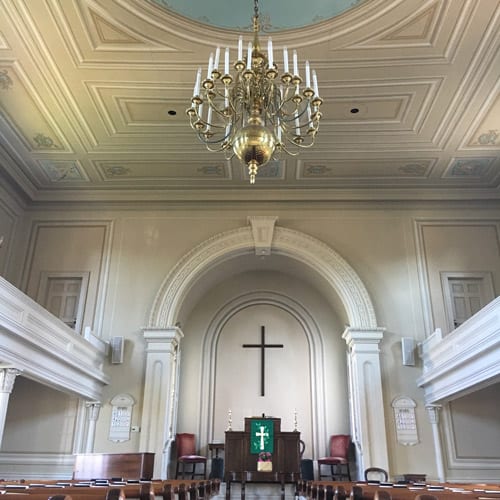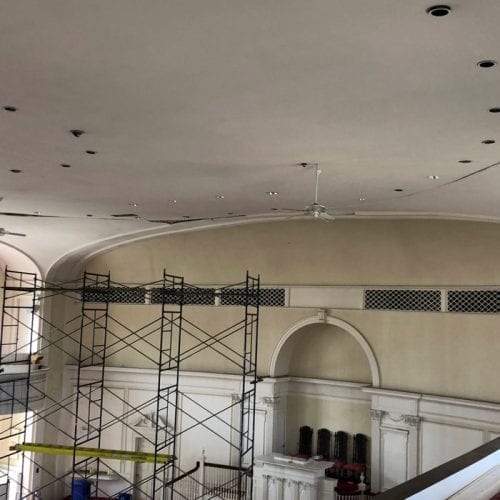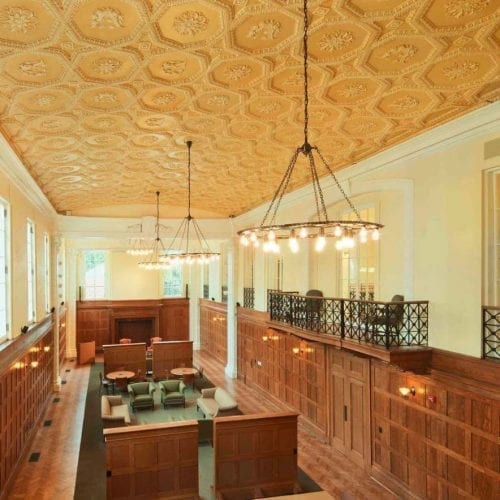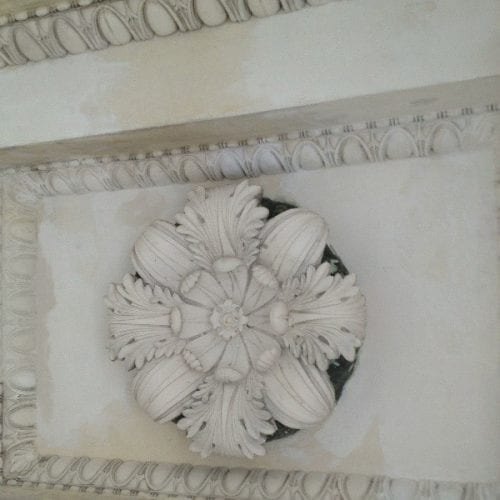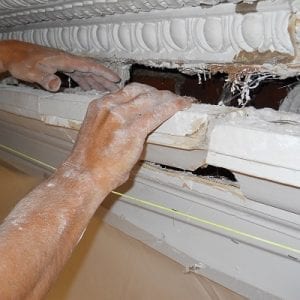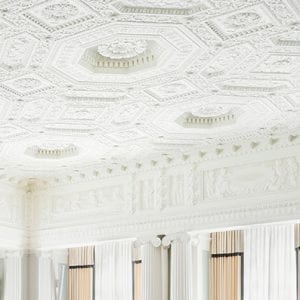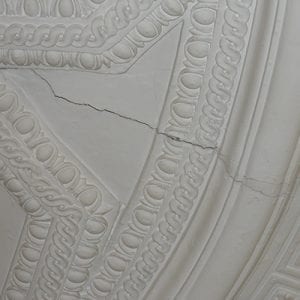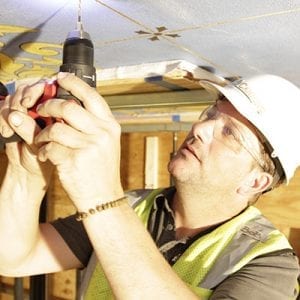Consolidation of Plaster on Wood Lath
Using the HPCS treatment method to tackle wood lath deterioration and failure.
Wood lath & plaster ceilings function as a suspended system. In the construction of the ceiling, a wooden board or towel is used to force the wet plaster through the gaps between strips of lath, so that the plaster “slumps” over the back of the lath to form a “key & lug”. This acts as a hook to hold the ceiling in suspension. The security of this suspended system depends on the integrity of the plaster keys & lugs.
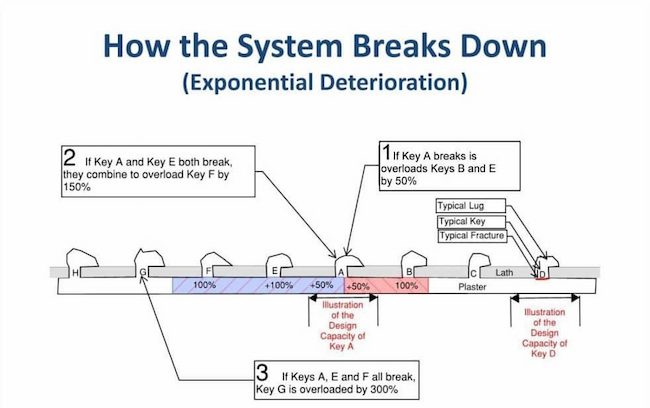
Over time this wood and plaster ceiling system begins to deteriorate and causes stresses on the keys & lugs. In turn, they will start to deteriorate and break. When one key breaks, the support work it was performing is passed on to the adjacent keys on either side. This represents a 50% increase in the load they were taking up. When the next key breaks, the load on its neighbor increases to 150%. As more and more keys break, the load on the neighboring keys increases exponentially which can lead to failure.
To ensure a wood lath & plaster ceiling remains strong, the broken keys must be replaced or reinforced. Reinforcing with new material or improved fastenings can help to redistribute the load and take some of the stress off the remaining keys. This will make sure the suspended system is secure and that it performs its intended purpose effectively.
Importance of HPCS Treatment
John Canning & Co.’s expertise in plaster conservation is among the most respected in the industry. We use the HPCS treatment method to tackle wood lath deterioration and failure projects. Other contractors might use the old process of repairing like-with-like based on the belief that only material similar in nature to the original material should be used, the standard wood screws and washers to re-secure ceiling & wall plaster or even spot injections of acrylic resin. The HPCS treatment method is far superior to all other treatment programs because it addresses the entire ceiling system rather than just isolated spots. The HPCS consolidation treatment method works just as well on plaster & wire lath as it does on plaster & wood lath.
By using the HPCS treatment method, John Canning & Co. can also ensure that the plaster is not compromised in any way. The process works by restoring the bond between the lath and plaster so that it can remain strong for years to come. The HPCS technique does not require a large amount of labor or materials, making it more cost effective than traditional methods. Not only does this process strengthen the plaster, but it also helps protect against future damage and deterioration. This makes the HPCS treatment method better suited to long-term preservation of the plaster system.
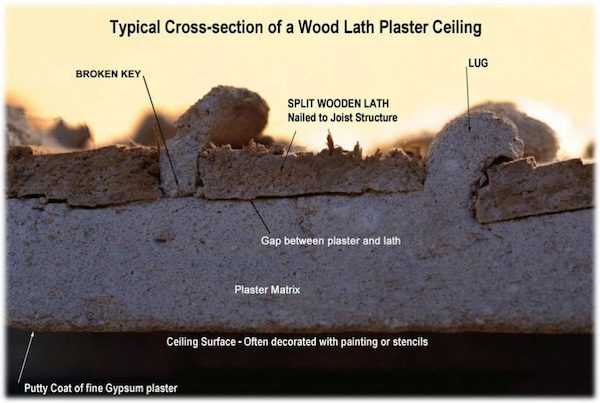
Need an expert opinion for your project? Request a Consultation
Our Process Lath and Plaster Consolidation
Often a plaster survey/assessment of the plaster and wood lath is required to determine the extent of the problems.
Following an assessment of the plaster, the steps involved with our process of treatment can be summarized by:
- Locating and inspecting structural components
- Thoroughly cleaning of plaster
- Application of acrylic resins
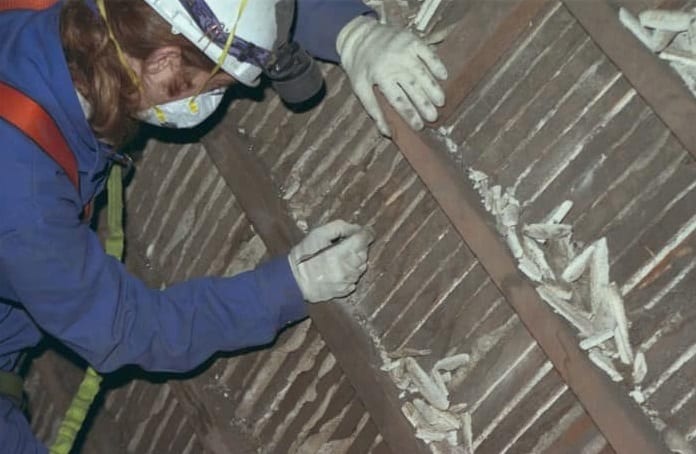
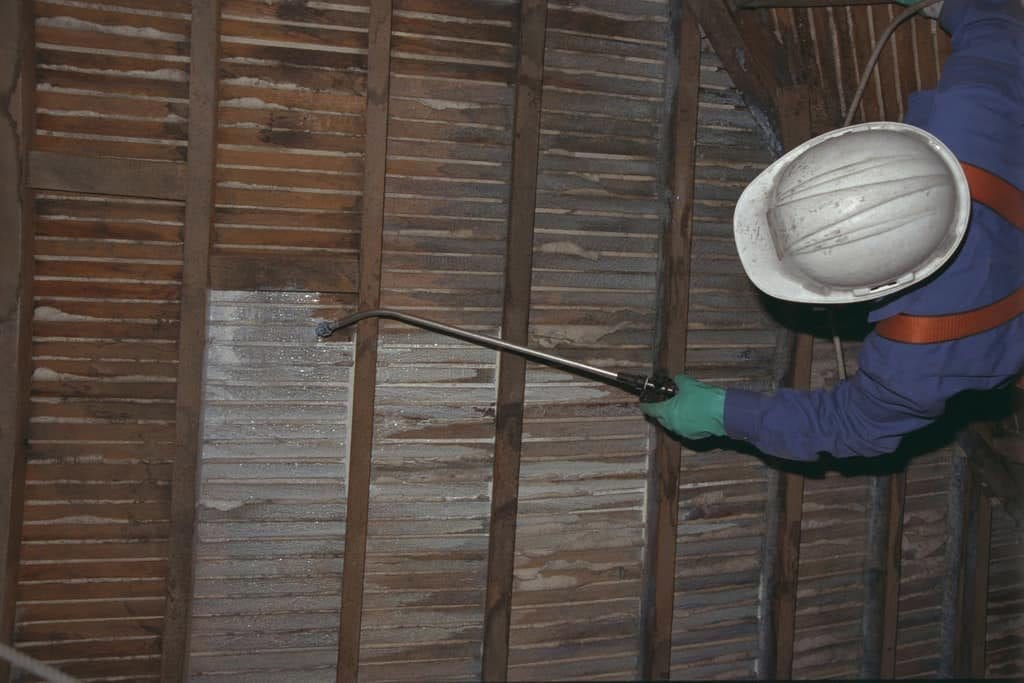
It is essential to inspect the structural components of the system to determine the extent of deterioration. Mechanical structural components are located on the backside of the plaster. Therefore, inspection must be conducted in the attic or by other means of accessing the backside of the plaster. Test areas are used where broken keys are counted and key & lug pull tests are performed.
The treatment method begins by thoroughly cleaning dirt and debris from the back of the plaster.
The plaster is then flooded with two applications of acrylic resins with different degrees of dilution, followed by an application of undiluted acrylic resin.
The acrylic resins are specially formulated to maximize penetration into the plaster base coats.
As one of the few authorized installers for Historic Plaster Conservation Services, we can implement the advanced technology required to save old plaster by addressing the problem at its root - where the plaster meets its substrate. In turn, this allows the HPCS method of plaster consolidation to accomplish five important objectives:
- It greatly strengthens the plaster matrix with the infusion of acrylic resins.
- It strongly adheres the plaster to the wood lath with flexible adhesive that can withstand the building’s vibrations and prevent cracking.
- It effectively converts the plaster ceiling from a fragile suspended system into a strong, consolidated adhered system.
- It addresses the entire ceiling system.
- It lasts a very long time.
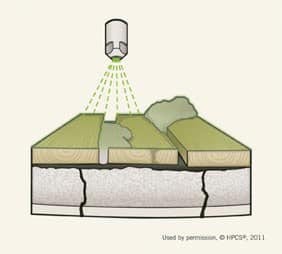
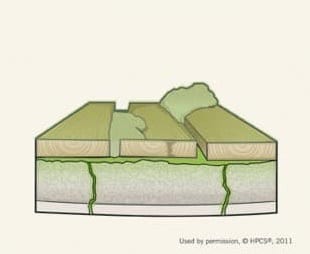
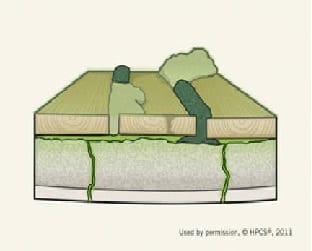
Cost Factors in Plaster Ceiling Consolidation
The exact cost of wood lath plaster consolidation naturally depends on a number of factors. These include, but are not limited to:
- Whether or not the process begins with a plaster conditions survey/assessment
- The size of the work
- If Removal of Insulation is needed
- The complexity of the work
- The location of the work, and required access (for example, whether or not scaffolding will be required to access the space)
- Special materials cost, such as consolidants, adhesives, etc.
For this reason, it is difficult to say what the “typical” cost for wood lath plaster consolidation may be. The surest way to get an accurate idea of what costs your project may entail is to contact us directly.
Our Specialty Restoration Services
In addition to consolidation of plaster on wood lath , we specialize in a number of other complementary services, including:
- Plaster Conditions Survey
- Plaster Restoration & Stabilization
- Ornamental, Flat, and Acoustic Plaster -Restoration & Replication
- Stabilization & Reinforcement of Fibrous Plaster Panels and Coffers
- Historic Building Conditions Assessment
- And more
A 100% Track record of success
Over the past 30 years, the HPCS treatment method has been used to consolidate more than 100 plaster ceilings in important buildings. TO date there has been no ongoing deterioration, no additional cracking, no failures, no maintenance costs incurred, no warranties exercised and no insurance claims filed.
Selected Projects
John Canning & Co. brought in GNCB Engineers to assess the structural integrity of the framing and joists and Canning assessed and documented the failing plaster substrate.
It was determined that the historic plaster ceiling had lost integrity and the plaster keys were deteriorating. The ceiling was consolidated from above using an adhesive injection system to stabilize and reinforce back to the supporting lath and framing.
We were able to uncovered original colors, patterns, and finishes to conserve 24 murals while restoring Stations of the Cross and the scagliola columns.
John Canning & Co. reattached the vaulted main dining room ceiling while also installing additional structural supports into the masonry and wood structure for the purposes of adding steel and wood supports.
Our projects at Michigan Capitol 1989-92 and 2016 required expert woodgraining matching skills, and innovation in plaster reattachment and distemper paint conservation, and every other decorative painting skill.
Different plaster and decorative treatment techniques were used throughout, as plaster stabilization, consolidation and repair were needed. Some of the other work included replication of molds and castings, patching and infill as well as framing and re-attachment.
We needed an expert in plaster restoration work. The structural engineer immediately recommended the John Canning & Co
Your research into period appropriate means and methods for the original installation was instrumental in changing the specification to a non-destructive repair and restructuring of the ceilings.

